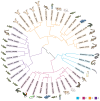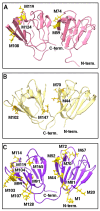The Functional Significance of High Cysteine Content in Eye Lens γ-Crystallins
- PMID: 38786000
- PMCID: PMC11118217
- DOI: 10.3390/biom14050594
The Functional Significance of High Cysteine Content in Eye Lens γ-Crystallins
Abstract
Cataract disease is strongly associated with progressively accumulating oxidative damage to the extremely long-lived crystallin proteins of the lens. Cysteine oxidation affects crystallin folding, interactions, and light-scattering aggregation especially strongly due to the formation of disulfide bridges. Minimizing crystallin aggregation is crucial for lifelong lens transparency, so one might expect the ubiquitous lens crystallin superfamilies (α and βγ) to contain little cysteine. Yet, the Cys content of γ-crystallins is well above the average for human proteins. We review literature relevant to this longstanding puzzle and take advantage of expanding genomic databases and improved machine learning tools for protein structure prediction to investigate it further. We observe remarkably low Cys conservation in the βγ-crystallin superfamily; however, in γ-crystallin, the spatial positioning of Cys residues is clearly fine-tuned by evolution. We propose that the requirements of long-term lens transparency and high lens optical power impose competing evolutionary pressures on lens βγ-crystallins, leading to distinct adaptations: high Cys content in γ-crystallins but low in βB-crystallins. Aquatic species need more powerful lenses than terrestrial ones, which explains the high methionine content of many fish γ- (and even β-) crystallins. Finally, we discuss synergies between sulfur-containing and aromatic residues in crystallins and suggest future experimental directions.
Keywords: cataract; crystallin; cysteine; disulfide; eye lens; methionine; protein aggregation; protein evolution; protein misfolding; refractive index.
Conflict of interest statement
The authors declare no conflicts of interest.
Figures






Similar articles
-
Gamma crystallins of the human eye lens.Biochim Biophys Acta. 2016 Jan;1860(1 Pt B):333-43. doi: 10.1016/j.bbagen.2015.06.007. Epub 2015 Jun 25. Biochim Biophys Acta. 2016. PMID: 26116913 Review.
-
Reactive cysteine residues in the oxidative dimerization and Cu2+ induced aggregation of human γD-crystallin: Implications for age-related cataract.Biochim Biophys Acta Mol Basis Dis. 2018 Nov;1864(11):3595-3604. doi: 10.1016/j.bbadis.2018.08.021. Epub 2018 Aug 18. Biochim Biophys Acta Mol Basis Dis. 2018. PMID: 30251679 Free PMC article.
-
Site specific oxidation of amino acid residues in rat lens γ-crystallin induced by low-dose γ-irradiation.Biochem Biophys Res Commun. 2015 Oct 30;466(4):622-8. doi: 10.1016/j.bbrc.2015.09.075. Epub 2015 Sep 16. Biochem Biophys Res Commun. 2015. PMID: 26385181
-
Molecular evolution of the betagamma lens crystallin superfamily: evidence for a retained ancestral function in gamma N crystallins?Mol Biol Evol. 2009 May;26(5):1127-42. doi: 10.1093/molbev/msp028. Epub 2009 Feb 20. Mol Biol Evol. 2009. PMID: 19233964
-
Crystallins and Their Complexes.Subcell Biochem. 2019;93:439-460. doi: 10.1007/978-3-030-28151-9_14. Subcell Biochem. 2019. PMID: 31939160 Review.
Cited by
-
Oxidative Stress in Cataract Formation: Is There a Treatment Approach on the Horizon?Antioxidants (Basel). 2024 Oct 16;13(10):1249. doi: 10.3390/antiox13101249. Antioxidants (Basel). 2024. PMID: 39456502 Free PMC article. Review.
-
The Eye Lens Protein, γS Crystallin, Undergoes Glutathionylation-Induced Disulfide Bonding Between Cysteines 22 and 26.Biomolecules. 2025 Mar 11;15(3):402. doi: 10.3390/biom15030402. Biomolecules. 2025. PMID: 40149938 Free PMC article.
-
Exploring proinsulin proteostasis: insights into beta cell health and diabetes.Front Mol Biosci. 2025 Mar 5;12:1554717. doi: 10.3389/fmolb.2025.1554717. eCollection 2025. Front Mol Biosci. 2025. PMID: 40109403 Free PMC article. Review.
References
Publication types
MeSH terms
Substances
Grants and funding
LinkOut - more resources
Full Text Sources

